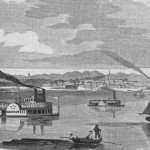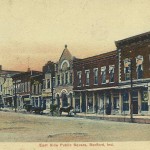After a massive fire and two stints on Historic Landmarks’ Ten Most Endangered list, an aging brick behemoth in Jeffersonville has been preserved and re-purposed.
Known as the world’s largest shirt factory during World War 1, the Jeffersonville Quartermaster Intermediate Depot enjoyed several incarnations and expansions after its inception during the Civil War.
Shirt-making began there on a piecework basis—the female relatives of Union soldiers would sew pre-cut shirts at home and return them to an inspection facility within the Jeffersonville General Hospital.
Just across the Ohio River from Louisville, Kentucky, Jeffersonville’s pivotal location—served by three national rail lines and a major waterway—made it a natural supply site for Union troops in the South. As such, Jeffersonville became one of nine principal depots across the nation. In addition to clothing, the depot supplied vehicles, stoves, saddles and hardtack, among other essentials.
It was only after the Civil War had ended that Jeffersonville was designated as the location for a permanent government depot. In 1871, a brick quadrangle covering four city blocks went up on a site formerly known as Vernon Place. Although Frederick Law Olmsted, best known as the father of Central Park, contributed distinctive features to the quadrangle’s design, his vision was overshadowed by that of Major General J. C. Meigs, the Quartermaster General of the Army.
Production at the depot stepped up in wartime, and the complex expanded to cover ten blocks. 100,000 shirts a month were produced there during the Spanish-American War, increasing to 700,000 a month during World War I, when the shirt factory became known as the world’s largest. Shirt-making moved to Philadelphia thereafter, but at Jeffersonville, production of other supplies for the troops during the Second World War reached $2.2 billion.
Though functional during the Korean War, the facility was shuttered thereafter.
Having housed a shopping center, a department of the U.S. Census Bureau, and a Christian recording studio, the Quadrangle has been rehabilitated. Since 2006, its Administration Building has served as the Jeffersonville City Hall.






















